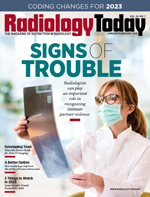 Editor’s Note: A Bigger Picture
Editor’s Note: A Bigger Picture
By David Yeager
Radiology Today
Vol. 24 No. 1 P. 4
Welcome to 2023. This time of year is often filled with thoughts of potential. People make plans and set goals in anticipation of better things ahead. This drive to improve affects all of us in one way or another. In radiology, the drive to improve manifests itself in many ways. It may show up in improved workflow or better technology, but the ultimate goal is better patient care. Several people at the RSNA conference this past November cited communication as another way that radiology can improve patient care. This may be communication with other physicians to collaborate on a case or communication with patients to explain imaging findings, but many people believe this is a path that will help maintain radiology’s standing in health care.
This issue’s cover feature deals with a difficult topic: intimate partner violence. Beth W. Orenstein takes a closer look at the pioneering research of Bharti Khurana, MD, FACR, FASER, and her efforts to understand this problem. Over the past several years, Khurana has compiled a great deal of information about what intimate partner violence looks like on medical imaging, and she wants people to know that it’s more prevalent than many realize. A key aspect of Khurana’s research, however, is that radiologists can help recognize the signs of intimate partner violence and collaborate with other medical personnel to get help for victims.
In CT news, Keith Loria has an update on the evolving role of AI in CT imaging. AI-based applications are helping radiologists identify various pathologies faster, with benefits for radiology and patients. Some algorithms can identify incidental findings so patients can be treated sooner. As Loria writes, although AI adoption is still in its early stages, the market is shifting, and AI algorithms are becoming an accepted tool for medical care.
Breast ultrasound is also undergoing a shift. The main drawback to breast ultrasound has been that it generates too many false positive results, but new technology is improving its specificity. Beth W. Orenstein reports on some advances, such as hybrid imaging, which uses ultrasound and optical imaging in combination, and shear wave elastography. AI is also helping to improve breast ultrasound’s utility. For all the details, turn to page 18.
Finally, we have our annual look at five trends from RSNA that may play a significant role in 2023.
— Dave Yeager
david.yeager@gvpub.com

